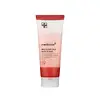What's inside
What's inside
 Key Ingredients
Key Ingredients

 Benefits
Benefits

 Concerns
Concerns

 Ingredients Side-by-side
Ingredients Side-by-side

Glycerin
HumectantSucrose
HumectantC12-14 Pareth-12
EmulsifyingSilica
AbrasiveSea Salt
AbrasiveWater
Skin ConditioningButylene Glycol
HumectantParfum
MaskingCaprylyl Glycol
EmollientHydroxyacetophenone
AntioxidantPentylene Glycol
Skin ConditioningCentella Asiatica Extract
CleansingEclipta Prostrata Extract
Skin ConditioningCoccinia Indica Fruit Extract
Skin ConditioningPolysilicone-15
UV Filter1,2-Hexanediol
Skin ConditioningFreesia Refracta Extract
Skin ConditioningMentha Piperita Leaf Extract
Skin ConditioningTocopherol
AntioxidantMonarda Didyma Leaf Extract
Skin ConditioningChamomilla Recutita Flower Extract
MaskingRosmarinus Officinalis Leaf Extract
AntimicrobialLavandula Angustifolia Extract
Skin ConditioningNiacinamide
SmoothingSalicylic Acid
MaskingGluconolactone
Skin ConditioningSaccharomyces Ferment
Skin ConditioningNelumbo Nucifera Leaf Extract
Skin ConditioningCryptomeria Japonica Leaf Extract
HumectantPueraria Lobata Root Extract
HumectantPinus Palustris Leaf Extract
TonicUlmus Davidiana Root Extract
Skin ConditioningOenothera Biennis Flower Extract
AstringentEthylhexylglycerin
Skin ConditioningGlycerin, Sucrose, C12-14 Pareth-12, Silica, Sea Salt, Water, Butylene Glycol, Parfum, Caprylyl Glycol, Hydroxyacetophenone, Pentylene Glycol, Centella Asiatica Extract, Eclipta Prostrata Extract, Coccinia Indica Fruit Extract, Polysilicone-15, 1,2-Hexanediol, Freesia Refracta Extract, Mentha Piperita Leaf Extract, Tocopherol, Monarda Didyma Leaf Extract, Chamomilla Recutita Flower Extract, Rosmarinus Officinalis Leaf Extract, Lavandula Angustifolia Extract, Niacinamide, Salicylic Acid, Gluconolactone, Saccharomyces Ferment, Nelumbo Nucifera Leaf Extract, Cryptomeria Japonica Leaf Extract, Pueraria Lobata Root Extract, Pinus Palustris Leaf Extract, Ulmus Davidiana Root Extract, Oenothera Biennis Flower Extract, Ethylhexylglycerin
Pumice
AbrasiveWater
Skin ConditioningGlycolic Acid
BufferingSodium Cocoyl Isethionate
CleansingLactic Acid
BufferingDimethicone
EmollientStearic Acid
CleansingCetearyl Alcohol
EmollientSodium Hydroxide
BufferingPalmitic Acid
EmollientGlycerin
HumectantC12-15 Alkyl Benzoate
AntimicrobialSorbitol
HumectantColloidal Oatmeal
AbsorbentTocopherol
AntioxidantChrysanthemum Parthenium Extract
Skin ConditioningCamellia Sinensis Leaf Extract
AntimicrobialGlycyrrhiza Glabra Root Extract
BleachingSalix Nigra Bark Extract
Skin ProtectingBisabolol
MaskingHydrogenated Coconut Acid
EmollientXanthan Gum
EmulsifyingSteareth-20
CleansingSteareth-21
CleansingMyristic Acid
CleansingSodium Isethionate
CleansingPhenoxyethanol
PreservativePotassium Sorbate
PreservativeSodium Benzoate
MaskingLeuconostoc/Radish Root Ferment Filtrate
AntimicrobialEDTA
Pumice, Water, Glycolic Acid, Sodium Cocoyl Isethionate, Lactic Acid, Dimethicone, Stearic Acid, Cetearyl Alcohol, Sodium Hydroxide, Palmitic Acid, Glycerin, C12-15 Alkyl Benzoate, Sorbitol, Colloidal Oatmeal, Tocopherol, Chrysanthemum Parthenium Extract, Camellia Sinensis Leaf Extract, Glycyrrhiza Glabra Root Extract, Salix Nigra Bark Extract, Bisabolol, Hydrogenated Coconut Acid, Xanthan Gum, Steareth-20, Steareth-21, Myristic Acid, Sodium Isethionate, Phenoxyethanol, Potassium Sorbate, Sodium Benzoate, Leuconostoc/Radish Root Ferment Filtrate, EDTA
 Reviews
Reviews

Alternatives
Ingredients Explained
These ingredients are found in both products.
Ingredients higher up in an ingredient list are typically present in a larger amount.
Glycerin is already naturally found in your skin. It helps moisturize and protect your skin.
A study from 2016 found glycerin to be more effective as a humectant than AHAs and hyaluronic acid.
As a humectant, it helps the skin stay hydrated by pulling moisture to your skin. The low molecular weight of glycerin allows it to pull moisture into the deeper layers of your skin.
Hydrated skin improves your skin barrier; Your skin barrier helps protect against irritants and bacteria.
Glycerin has also been found to have antimicrobial and antiviral properties. Due to these properties, glycerin is often used in wound and burn treatments.
In cosmetics, glycerin is usually derived from plants such as soybean or palm. However, it can also be sourced from animals, such as tallow or animal fat.
This ingredient is organic, colorless, odorless, and non-toxic.
Glycerin is the name for this ingredient in American English. British English uses Glycerol/Glycerine.
Learn more about GlycerinTocopherol (also known as Vitamin E) is a common antioxidant used to help protect the skin from free-radicals and strengthen the skin barrier. It's also fat soluble - this means our skin is great at absorbing it.
Vitamin E also helps keep your natural skin lipids healthy. Your lipid skin barrier naturally consists of lipids, ceramides, and fatty acids. Vitamin E offers extra protection for your skin’s lipid barrier, keeping your skin healthy and nourished.
Another benefit is a bit of UV protection. Vitamin E helps reduce the damage caused by UVB rays. (It should not replace your sunscreen). Combining it with Vitamin C can decrease sunburned cells and hyperpigmentation after UV exposure.
You might have noticed Vitamin E + C often paired together. This is because it is great at stabilizing Vitamin C. Using the two together helps increase the effectiveness of both ingredients.
There are often claims that Vitamin E can reduce/prevent scarring, but these claims haven't been confirmed by scientific research.
Learn more about TocopherolWater. It's the most common cosmetic ingredient of all. You'll usually see it at the top of ingredient lists, meaning that it makes up the largest part of the product.
So why is it so popular? Water most often acts as a solvent - this means that it helps dissolve other ingredients into the formulation.
You'll also recognize water as that liquid we all need to stay alive. If you see this, drink a glass of water. Stay hydrated!
Learn more about Water